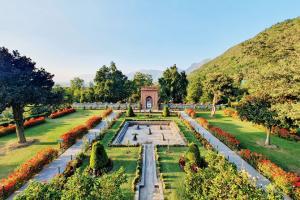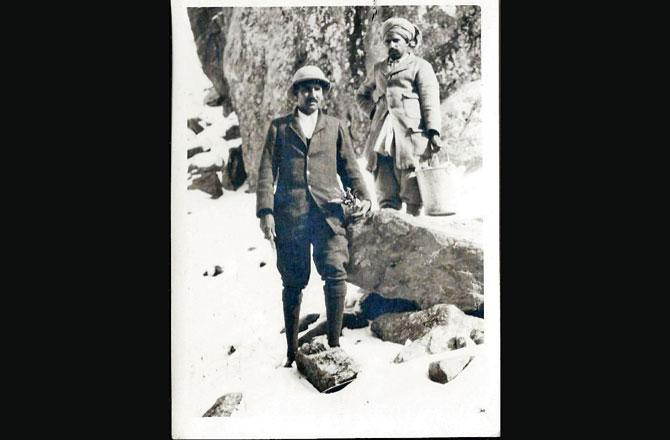Kashmirs six Mughal Gardens have a shot to earn the UNESCO World Heritage Site tag next year. Mumbai conservation architect Abha Narain Lambah makes a pitch for the 400-year-old "pleasure gardens" with which she shares a personal connect

The Chashma Shahi. The emperors found Kashmir so beautiful that they that built open, not walled gardens; the mountains were their walls
The lockdown has been a busy time for Abha Narain Lambah and team. "I got a special pass [issued by the civic body for essential service workers] made so that I could visit the sites I was working on across Mumbai," says the conservation architect behind the restoration of the BMC headquarters and Crawford Market. But the project that came her way as a proud challenge right before the lockdown in January, was the one involving Kashmir's six Mughal Gardens. The team was made in charge of preparing the crucial nomination dossier that would place the gardens among top contenders for the tag. "In the dead of winter, we were awarded the project. It is a serial nomination, where the proposal will cover all six imperial gardens built from 1620s to 1650s. These include four in Srinagar—Shalimar Bagh, Nishat Bagh (garden of joy), Chasma Shahi (royal spring) and Pari Mahal, and two in Anantnag—Achabal and Verinag," she explains.
Lambah, who interestingly traces her roots to Kashmir, pored over documents as part of research on the design of these royal gardens built and nurtured by the Mughals. "While Akbar was the first Mughal emperor to visit Kashmir, Babur is credited with the idea of building pleasure gardens in India. He built them in Agra, Dholpur and Panipat. Akbar refined the concept; he commissioned them in walled, urban spaces like Fatehpur Sikri. Jehangir and Shah Jahan took them to Kashmir, and raised garden architecture to the greatest heights," she elaborates, citing references from each of the emperors' memoirs.
ADVERTISEMENT

A 1927 photo of Lambah's grandfather Prem Nath Kohli. He was a botanist during the Dogra rule. Pics/Abha Narain Lambah
Persia to India
"The concept of paradise gardens is recurrent in Islam. Heaven is represented as a paradise garden in the Quran, and the emperors therefore, took it upon themselves to recreate heaven on earth," she explains, adding that the architecture and layout married geometry with topography. "The origins of this template date back to Persepolis. When Islam arrived in Persia, they adopted it as they did Islamic architecture. Hence, you can spot traces of it in Spain's Alhambra Mosque, all through Samarkand, Persia, Kabul and India. Islam was nurtured in arid terrain, and so, the gardens or patches of greenery became the oases built on the principles of qanat—an underground system of channels to flow subaltern water from hills to the plains."
Babur, a proud descendent of the Timurid dynasty, visited Samarkand and was inspired by its gardens. He built similar ones on Kabul's terraces. "During war, Babur took time off for garden building. It was his life's obsession," shares Lambah, reminding us that though the Mughals were fiercely savage warriors, they had a softer, aesthetic side that fuelled their love for the arts.

Lambah at Shalimar Bagh. The Mughal Gardens nomination is one of several that will be submitted from India, with only one being picked as the official nominee to represent the country
Jehangir and his wife, Noor Jehan, were so smitten by Kashmir's beauty that they decided to shift the court there. "It took three months for them to travel, and the Mughal durbar, its armies and government made the long journey. Where else could they see narcissus and roses grow in the same line?" she wonders poetically. "For them, Kashmir was the epitome of paradise. They had always sought it, and when they finally got it, it became a political statement. The couple hosted wine parties in the gardens, and they emerged as an integral aspect of political and leisurely life."
Survive the ages
Despite being over 400 years old, the gardens are impeccably preserved. Generations of caretakers continued to tend to and water them, says Lambah, because of their secular characteristic, unattached to mosques. Under the Treaty of Amritsar that followed in 1846, the British government sold Kashmir for a sum of 7.5 million Nanukshahee rupees to Gulab Singh, bestowing him with the title of Maharaja.
The Dogra dynasty to which he belonged, was famed for throwing lavish parties. "Prem Nath Kohli, my grandfather, was a botanist during the Dogra rule. He was manager with Maharaja Hari Singh's private estates. When the Maharaja was exiled, he transferred the power of attorney to him," she says, revealing her family's link with these gardens. "While growing up in Srinagar, we'd revel in picnic lunches on these lawns. We would carry pots with rice, rajma, rogan josh, and roll out carpets," she recalls.
In fact, her mother Kiran has helped identify several plant species for the dossier. "She is excited about this. The gardens are part of their heritage and identity. Literature in Urdu, Persian and Kashmiri pays rich tribute to them."
The dossier submission is the first step. The Archaeological Survey of India has shared the dossier with UNESCO, Paris, for a completion check. The real challenge will be to ensure it makes the cut as India's official nomination in January 2021. "The nomination is an ideal instrument of recognition to make it a better space. Perhaps, it's the right time for Kashmir," Lambah signs off.
Keep scrolling to read more news
Catch up on all the latest Mumbai news, crime news, current affairs, and a complete guide from food to things to do and events across Mumbai. Also download the new mid-day Android and iOS apps to get latest updates.
Mid-Day is now on Telegram. Click here to join our channel (@middayinfomedialtd) and stay updated with the latest news
 Subscribe today by clicking the link and stay updated with the latest news!" Click here!
Subscribe today by clicking the link and stay updated with the latest news!" Click here!







